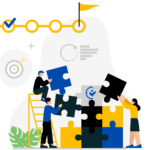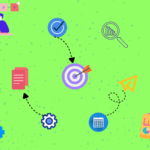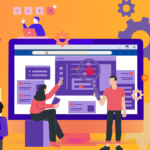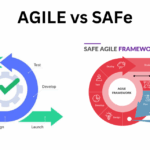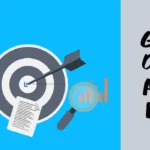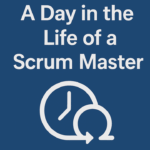Home / Our Blog / Software Development Lifecycle (SDLC): A Complete, Practical Guide
Software Development Lifecycle (SDLC): A Complete, Practical Guide
Aug 20, 2025 Educational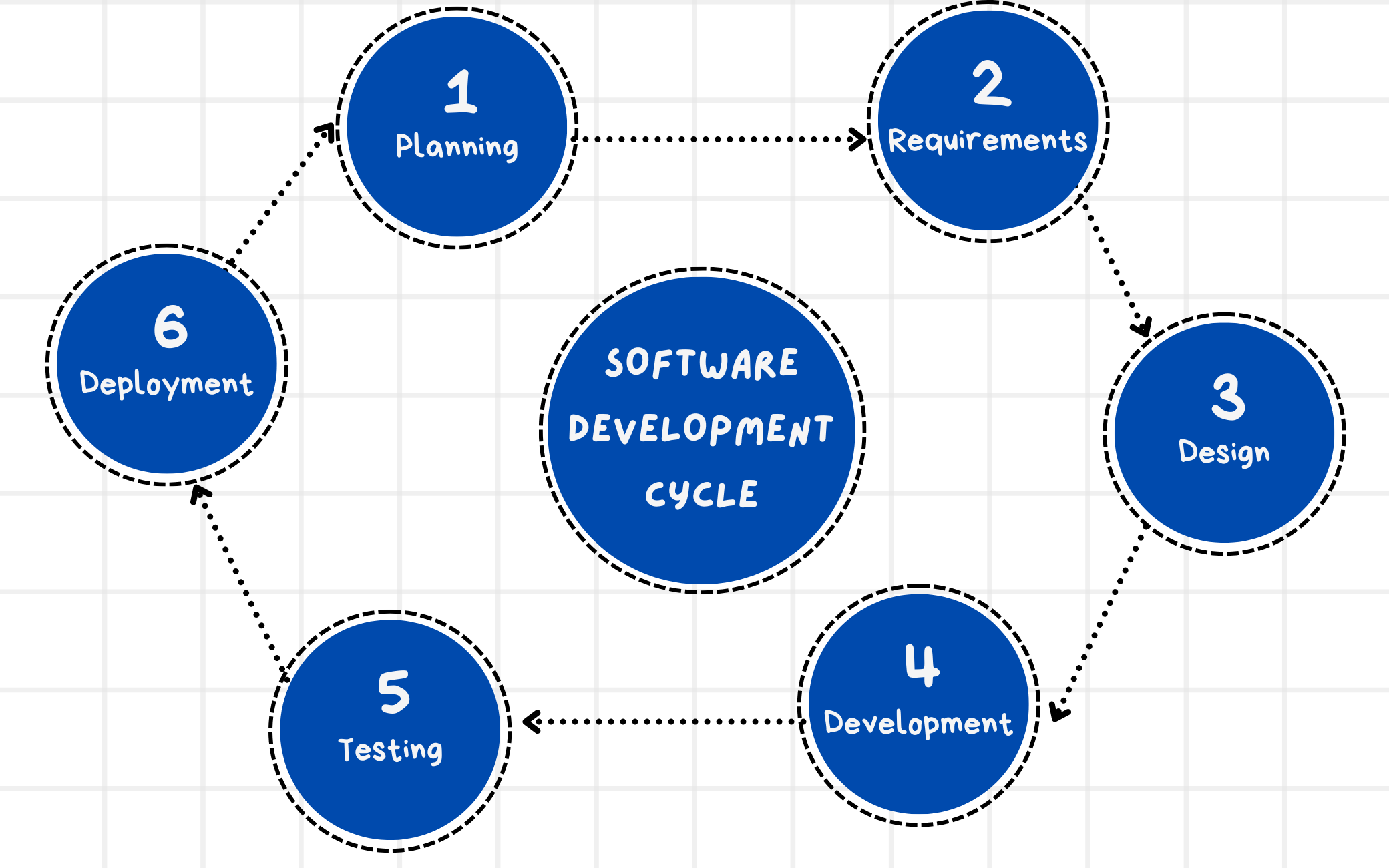
Building software without a plan is like wandering into a maze without a map. You might stumble onto the exit eventually, but you’ll hit dead ends, waste time, and possibly give up in frustration.
It’s not just theory, a BCG survey found nearly half of tech projects run late or over budget, and one in five fail in more than half their attempts. Clearly, winging it doesn’t work.
That’s where the Software Development Lifecycle (SDLC) comes in. It’s a framework that brings structure, predictability, and quality to software projects. Whether you’re crafting a small app or a massive enterprise platform, SDLC guides teams from idea to launch, and beyond.
With Scrum Slate, managing this lifecycle is easier than ever. Everything, from planning and coding to testing and deployment, lives in one platform, so your team stays focused and aligned.
What Exactly Is the SDLC?
Think of SDLC as the blueprint for building software. It’s not just about writing code; it’s about making sure the code you write solves the right problem, works reliably, and can evolve over time.
At its core, SDLC follows a series of stages: planning, requirements, design, development, testing, deployment, and maintenance. But these stages aren’t carved in stone, different projects mix and adapt them using models like Waterfall, Agile, or Spiral.
The beauty of SDLC? It saves teams from endless guesswork, missed deadlines, and bloated budgets. It also gives everyone, from developers to stakeholders, a clear picture of where the project stands and where it’s headed.
The 7 Phases of the Software Development Lifecycle
Each phase builds on the previous one, creating a clear path from idea to finished product. Let’s explore each phase in detail.
1. Planning
Every software project begins with a question: Why are we building this?
Teams define the purpose, scope, and direction before touching any code. This is when big decisions happen, setting goals, budgeting, creating rough timelines, and spotting potential risks.
Key activities in this phase:
- Define goals: What problem does the software solve?
- Set budgets and timelines: How much can you spend, and how long will it take?
- Feasibility studies: Is the project technically and financially possible?
- Risk analysis: Identify obstacles like resource shortages or market uncertainties.
- Project scheduling: Assign roles, responsibilities, and milestones.
Imagine a startup designing a food delivery app. They decide to launch in three cities, set aside $150,000, and aim for a six-month release. But they also flag restaurant onboarding as a possible bottleneck. That awareness early on saves painful surprises later.
Good planning isn’t just paperwork; it’s alignment. Everyone knows the mission, and no one is guessing what success looks like.
With Scrum Slate, planning stops being a guessing game. Teams can set goals, estimate budgets, and identify risks in a single shared workspace, no scattered spreadsheets, no endless email threads. Everyone stays on the same page from day one.
2. Requirements Gathering and Analysis – Knowing What to Build
After deciding why to build, the next step is figuring out what to build. Teams talk to stakeholders, customers, and end users to uncover real needs. These insights turn into detailed requirements or user stories that describe how the software should behave in real life.
Key activities in this phase:
- Stakeholder interviews: Speak directly to users, clients, and decision-makers.
- Document requirements: Turn findings into detailed specifications.
- Create user stories: Describe how people will use the product in real scenarios.
- Validate requirements: Confirm that everyone agrees on what’s being built.
Example: Mozilla gathers user feedback to improve Firefox features like speed and privacy. This ensures new features actually solve real problems.
This stage is about clarity. A feature no one understands or wants is worse than no feature at all.
Scrum Slate makes gathering and managing requirements simple. You can log stakeholder feedback, prioritize features, and turn ideas into actionable user stories without losing track of what matters most.
Capture every detail and never miss a must-have feature — organize your requirements in Scrum Slate.
3. Design – Creating the Blueprint
Once you know what to build, it’s time to sketch out how it will work. Think of this as drawing the map before starting the journey. Developers and designers work together to create wireframes, system diagrams, and database plans.
Key activities in this phase:
- Wireframes and mockups: Show how users will interact with the product.
- System architecture: Define how components will work together.
- Technical specifications: Choose tech stacks, frameworks, and tools.
- Database design: Plan how data will be stored and secured.
Google’s Material Design is a great example of design done right. By setting clear guidelines for layouts, colors, and interactions, Google made sure thousands of apps, both inside and outside its ecosystem, feel consistent and user-friendly.
The goal here isn’t to decorate the software; it’s to ensure developers have a clear, structured plan so coding feels less like guesswork and more like construction.
4. Development
This is where ideas turn into actual software. Developers write code, integrate components, and collaborate closely to make everything work as planned.
Modern teams build in small, modular chunks to test as they go rather than waiting until the end. Tools like Git track every change so multiple developers can work together without chaos.
Key activities in this phase:
- Write and review code: Developers build features step by step.
- Use version control: Tools like Git help teams collaborate without conflicts.
- Build in modules: Smaller chunks make testing and updates easier.
- Integrate components: Connect front-end, back-end, and APIs seamlessly.
Example: Teams using Scrum Slate can manage tasks, code reviews, and progress in one place instead of juggling multiple tools.
With Scrum Slate, teams don’t waste time switching between different apps for project tracking, code reviews, and updates. Everything lives in one place, meaning developers focus on writing solid code instead of chasing status updates.
5. Testing
Before software goes live, it needs to prove itself. Testing isn’t a single step; it’s an ongoing process woven throughout development.
From unit testing individual functions to stress-testing the entire system under heavy loads, every layer of testing ensures the software behaves as expected. Security checks protect sensitive data, while user acceptance testing confirms the product actually meets real needs.
Well-tested software saves teams from angry users and late-night bug hunts. It’s like finding leaks in a roof before the rainy season, not after.
Common types of testing:
- Unit Testing: Check individual components.
- Integration Testing: Ensure modules work together.
- Performance Testing: Test speed and stability under different conditions.
- User Acceptance Testing (UAT): Make sure the product meets user needs.
- Security Testing: Identify vulnerabilities and protect data.
Track bugs, assign fixes, and verify them — all without leaving Scrum Slate. QA teams see exactly what’s ready for testing, and developers get instant feedback so issues don’t pile up at the end.
Deliver bug-free software faster by managing testing in Scrum Slate.
6. Deployment
When testing shows the product is stable, it’s time to launch. But deployment isn’t just pressing a “go live” button. Teams choose between full rollouts, gradual releases, or beta launches to catch issues early.
Microsoft often uses phased rollouts, starting with a smaller Insider Program group before delivering updates to millions of users. This strategy reduces risk and ensures smoother adoption.
Deployment also includes training users, providing documentation, and keeping an eye out for issues as soon as the product goes live.
Key activities in this phase:
- Deploy to production: Release the software to live environments.
- Gradual rollout: Launch in small stages to catch issues early.
- User training: Provide guides, documentation, or sessions to help users.
- Monitor post-launch: Track any problems and fix them quickly.
7. Maintenance and Support
Launch day isn’t the finish line, it’s the start of a long relationship. Software must be updated, improved, and secured over time.
Teams fix bugs, release new features, and adapt to changing user expectations. Look at Apache HTTP Server, still going strong after more than 25 years thanks to continuous updates and security patches.
Good maintenance keeps software relevant, safe, and efficient long after the initial release.
Key activities in this phase:
- Fix bugs: Address problems reported by users.
- Update features: Add improvements or adjust based on feedback.
- Security patches: Keep systems safe from new threats.
- Monitor performance: Ensure long-term stability and usability.
Popular SDLC Models and How They Work
Not every project follows these stages the same way. Different SDLC models help teams adapt to unique challenges:
- Waterfall Model: A strict step-by-step approach where one phase must finish before the next begins. Best for projects with fixed requirements, like aerospace or government systems.
- Iterative Model: Build a basic version first, then refine it through repeated cycles. Perfect when requirements are unclear or evolving.
- Agile Methodology: Work in short sprints, release small updates frequently, and adapt quickly to feedback. PayPal famously switched to Agile and skyrocketed from 3 launches in 18 months to 58 in just 6 months.
- Spiral Model: Combines Waterfall’s structure with Agile’s flexibility, focusing heavily on risk management. Used for large, complex projects.
- V-Model: Extends Waterfall with built-in testing at every stage. Common in industries like healthcare, where software must meet strict safety and compliance standards.
Final Thoughts
The Software Development Lifecycle isn’t just theory, it’s how successful teams build software that works. With a clear process, you get predictable timelines, controlled costs, and products people actually love.
Scrum Slate takes the pain out of managing SDLC. Instead of juggling a dozen tools, everything your team needs, planning, development, testing, deployment, is right there in one platform. That means less chaos and more focus on what really matters: delivering great software.
